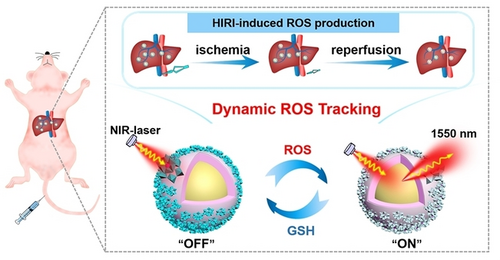Tracking Hepatic Ischemia-Reperfusion Injury in Real Time with a Reversible NIR-IIb Fluorescent Redox Probe
Graphical Abstract
A reversible fluorescent redox probe with emission beyond 1500 nm was synthesized to dynamically monitor the time-resolved reactive oxygen species (ROS) fluctuations during hepatic ischemia-reperfusion injury (HIRI) in vivo. The strategy not only circumvents the difficulty in building reversible fluorescent probes in the NIR-II region but also offers a useful tool for early diagnosis and timely treatment of HIRI.
Abstract
Hepatic ischemia-reperfusion injury (HIRI) is responsible for liver dysfunction, which involves reactive oxygen species (ROS) as the most critical marker. Real-time monitoring of ROS during HIRI can provide significant chance for early diagnosis and timely intervention. However, there is no probe available to track ROS fluctuations during HIRI in vivo, as it is extremely challenging to design reversibly responsive fluorescent probe in near-infrared region. Here, a reversible redox probe REPOMs emitting beyond 1500 nm is proposed to fill the blank, using rare earth ions-doped nanoparticles as emitter, and molybdenum-based polyoxometalate nanoclusters as the ROS-recognition site and emission modulator. REPOMs exhibited excellent response towards the repeated cycle between ROS and glutathione, based on which the time-resolved ROS changes during HIRI were successfully obtained. This reversible probe may provide a powerful tool to promote the hepatology research in the future.
Conflict of interest
The authors declare no conflict of interest.
Open Research
Data Availability Statement
The data that support the findings of this study are available from the corresponding author upon reasonable request.





